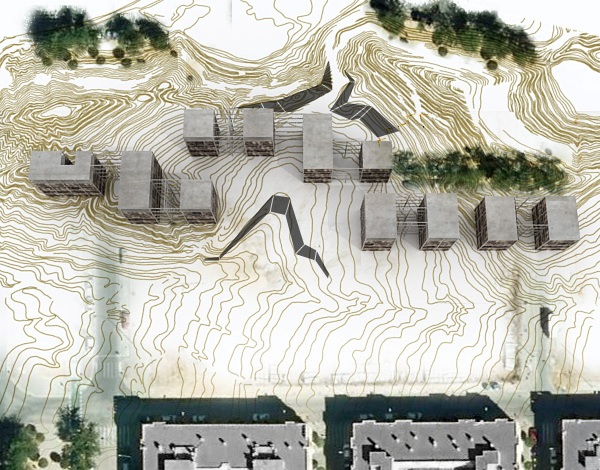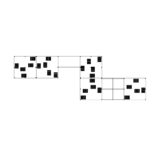Displaced typologies
Pablo Blázquez Jesús


Spanish suburbs are a monotonous landscape of abandoned concrete
structures. At a time when there is once again a demand for burial
grounds far away from the city, interest in these premature ruins
has been increasing: would it be possible to recycle these empty
shells by transforming them into cemeteries?
The proposed project understands that the deterioration of such
buildings is an intrinsic element of the operation. The buildings
will be encased in an outer layer made from debris found nearby,
built from recycled wire mesh and corrugated bars. Coffins and
funerary urns will be placed gradually into the skeleton of the
building following a particular pattern that will ensure the even
distribution of the weight over each floor. The structures of the
abandoned buildings, built to support 2 KN/m2 according to the
Spanish Technical Building Code, would eventually collapse. A huge
pile of debris would ultimately bury the building as if it were an
enormous modern tumulus.
In 1984 Enric Miralles and Carme Pinós won a competition to
replace and extend the old Igualada Cemetery. In the proposal,
“Miralles gave time factor an instrumental role, since it allows
people to imagine the growth of the foliage and tree trunks until
the gap is closed up; at that moment the whole cemetery would
disappear, turning into a huge communal grave with a green carpet
posing as a discreet gravestone covering. In the end, the cemetery
will once again (…) be underground: one sole grave recaptured,
occupied by vegetation, thus achieving the long-awaited return to
the earth.”
The Cortijo de las Colonias estate is part of the scenery in
Barranco de Víznar. The remains of an old mill and two pools shape
a landscape dotted with olive trees. A staggered, gleaming path
leads us to the old pool. The last stone looks twisted compared to
the others. Water flows over the words of what appears to be a
poem. Architect Carmen Moreno Álvarez’s minimal intervention in
that tragic enclave makes it possible to follow Federico García
Lorca’s final steps. It is easy to imagine that in many years,
similar feelings will be rekindled by someone discovering a little
gap on the brink of closing up in the outskirts of Igualada.
After many years of operation, the landfill site in Vall d’en Joan
was closed down. In 1999, a team of architects from Battle i Roig
Arquitectes developed a system by which they intended to totally
seal off the dumping site. Through the recycling of debris, the
project created several platforms and paths that provided access
to the Parque Natural del Garraf. By 2010 the landfill had been
completely reintegrated into the landscape.
The successful project in El Garraf, as well as the poetic and
forthcoming sentiments felt by walkers in the outskirts of
Igualada, serve as a catalyst for reproducing these experiences in
the thousands of abandoned structures around the country: the
outer layer made of debris covering the skeletons of the
buildings, put in place at the start of the procedure, would cover
the grave once the building had collapsed. Given time and the
growth of vegetation, the elevations that would emerge in the
outskirts of the cities would be covered up, creating a wide green
belt of up to 200 metres in which the construction of new
buildings would be prohibited. The mountain of debris would become
a protection tool against future urban growth and development
thanks to the displacement of the house-temple-grave vector.
Credits
Displaced typologies
Author:
Pablo Blázquez Jesús
Project team:
Jorge Iván Guerrero Ramírez, Yaiza Sellés Lloret
2016
